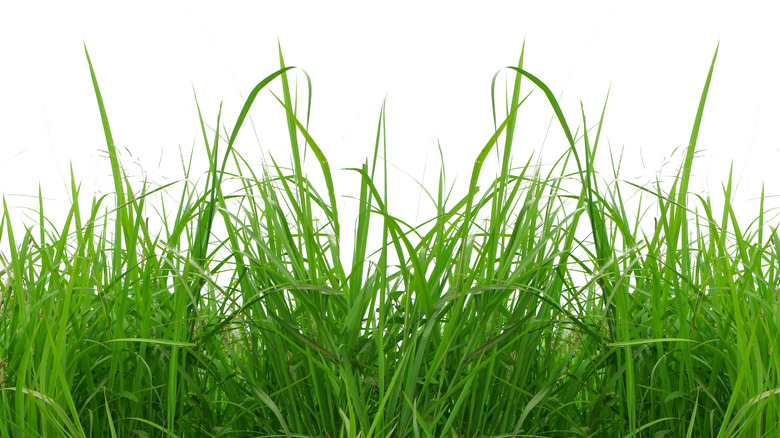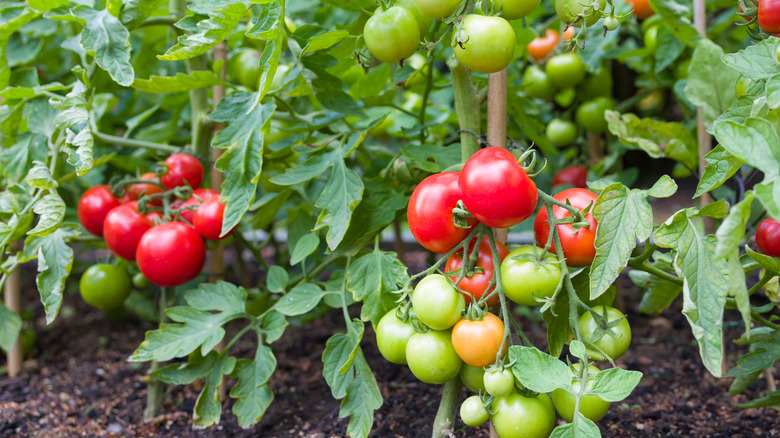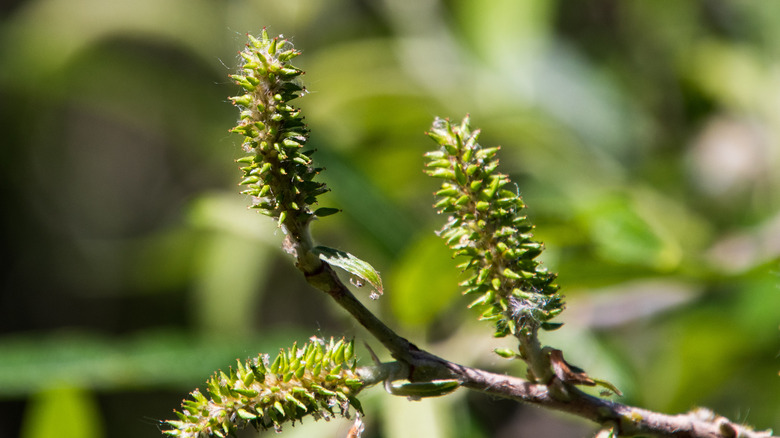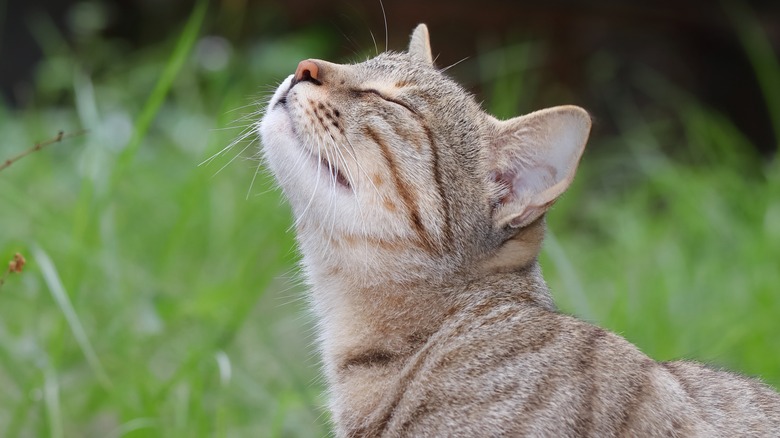The Macabre Truth Of The Smell Of Fresh-Cut Grass
There's nothing like the smell of a fresh-cut lawn. It's the fragrant herald of summer on the last cusp of spring, signaling afternoons at the park, baseball, and late sunsets where you can stay outside until after seven. But have you ever stopped to consider why cut grass smells at all?
When grass is cut, enzymes begin breaking down fats and other chemicals to create acids which are further broken down. What remains is a stew of organic compounds that are released into the air and find their way into chemoreceptors in our nose (via Compound Interest).
One of those chemicals, (Z)-3-hexenal, has an odor threshold (the minimum amount of a compound that needs to be present for it to be smelled by most people) of 0.25 parts per billion. Compare that to limonene, one of the organic compounds that gives oranges their aroma, which has an odor threshold of 200 parts per billion (via Foods and Food Science and Technology Research).
Why is the grass screaming?
Scientists aren't really sure why grass releases this melange of chemicals collectively known as green leaf volatiles. Research published in BMC Plant Biology suggests that this GLV burst is a medium of chemical communication, not just between the grasses, but to other plants as well.
Scientists looked at the expression of genes responsible for wound response and metabolism, then compared the expressions of those genes in grass that had been cut to grass that had been exposed to GLVs. They found a similar pattern of gene expression in each group. Further, they found that plants exposed to the GLVs but not the cutting displayed a sort of priming behavior. That is, the GLV seemed to prime the defense and recuperation mechanisms of the uncut grass in anticipation of impending damage. Contrary to most pop-science floating around out there, the grass isn't screaming in pain. It's shouting a warning to its brethren that danger is coming.
This isn't unique to grass
Green leaf volatiles are produced by plants like tobacco and cotton when they are infested with tobacco budworm. These GLVs attract the Cardiochiles nigriceps wasp which then parasitize the budworm, giving an immediate benefit to the afflicted plant and a long-term benefit to other plants nearby. When these plants are infested by larva which aren't hosts to the wasps, the wasps aren't attracted to the plants (via Plant Biotechnology).
These chemical communications can also cross the species barrier and carry very specific messages. Scientists exposed cabbage plants to three different pests: cutworms, spider mites, and diamondback moth larvae. They then collected the volatile extracts produced by the different cabbage cohorts. The cutworms and spider mites also feed on lima bean plants; diamondback moth larvae do not. When the lima bean plants were exposed to volatile compounds from cabbage damaged by cutworms and spider mites, they began producing defensive chemicals, but not when exposed to compounds from cabbage exposed to diamondback moth larvae.
The science we almost lost
The science of inter-plant communication began in the early '80s. Scientists had thought that plants were mostly passive when it came to threats like pests, but that paradigm began to fall away when it was found that trees could actively respond to cicada swarms by making their leaves less tasty for the ravenous bugs (via Quanta Magazine).
In 1983 a paper was published that found that not only were trees actively defending themselves by altering their chemistry, they were alerting other nearby trees to alter their chemistry in response. This was the first paper to suggest an airborne mechanism for plant-to-plant communication. That same year, other scientists found that pristine tree saplings would produce anti-pest compounds when placed in close proximity with saplings with damaged leaves. The next year, their work was attacked by a prominent ecologist who denounced their research methods and conclusions. The burgeoning field of plant-to-plant communication didn't recover for almost a decade.
Why are we fine-tuned to smell cut grass?
We've already talked about (Z)-3-hexenal being the primary chemical we smell after grass is cut. It turns out it's in a lot of different fruits we like. Odor is a complex phenomenon arising from the combination and interplay of many chemicals, and one of the chemicals responsible for the rich smell of tomatoes is none other than (Z)-3-hexenal. And a derivative of (Z)-3-hexenal, trans-2-hexenal is responsible for the flavor of fresh apple juice (via Chemistry World).
A paper in Chemical Senses outlines an experiment measuring the reduction in reaction times of monkeys and humans over an extended period. It found that the reductions in reaction times seen in a control group were reduced in the group exposed to these chemical compounds. In other words, that fresh-cut scent actually revitalizes us. The study authors are unsure if this is a physiological or psychological response.
So the reason we like the smell of grass isn't just because it reminds us of summer. It's the smell of fresh fruit and it literally makes you feel better.
It's all thanks to grass
It's not hyperbole to say that we owe our existence to grass. Gazing back into prehistory, it's thanks to the proliferation of grass that we have large grazing animals. Those animals, and the grass varieties that gave rise to them, became the staple of hunter-gatherer cultures (via The New York Times).
The domestication of grass, in particular wheat and barley, was one of the cornerstones of the first civilizations (via National Geographic). Even today, four grass crops — wheat, rice, corn, and sugar cane — comprise over half of the world's calorie intake (not to mention the vast number of grains produced to support meat production).
And just as grasses have helped lift us up, they may contribute to our downfall as well. Scientists in Australia have found that the volatile compounds released by grasses, particularly when they are cut, contribute to urban and rural smog (via Science Daily). So, just as grass releases chemicals to harm bugs, it could also be releasing chemicals to harm us.





